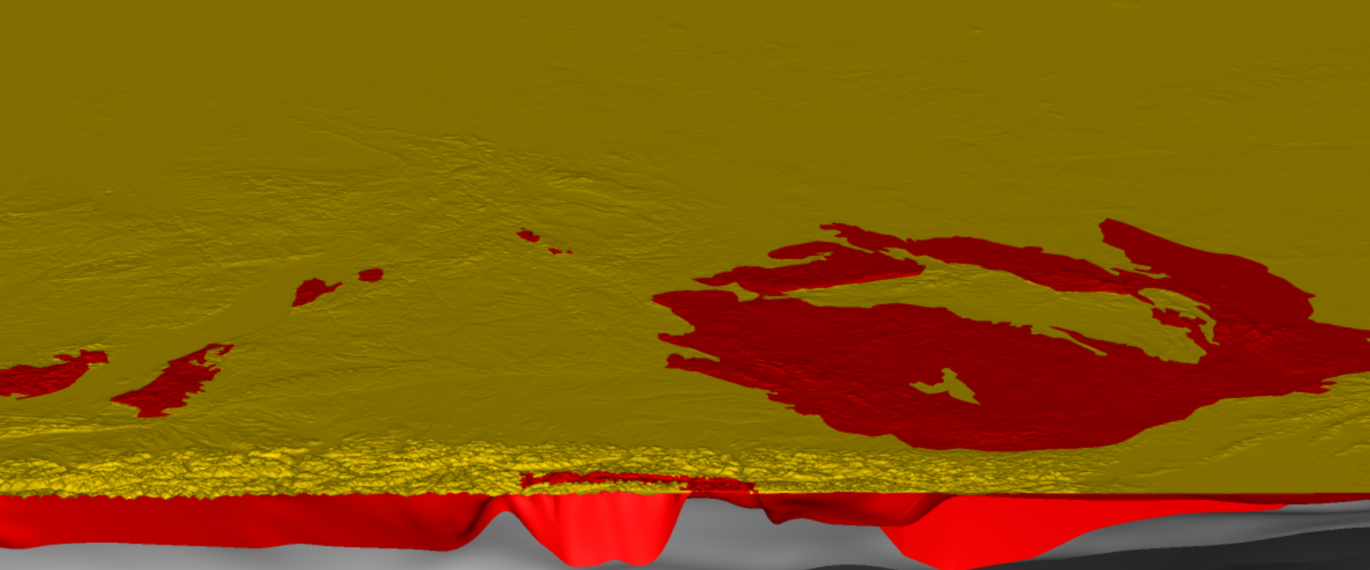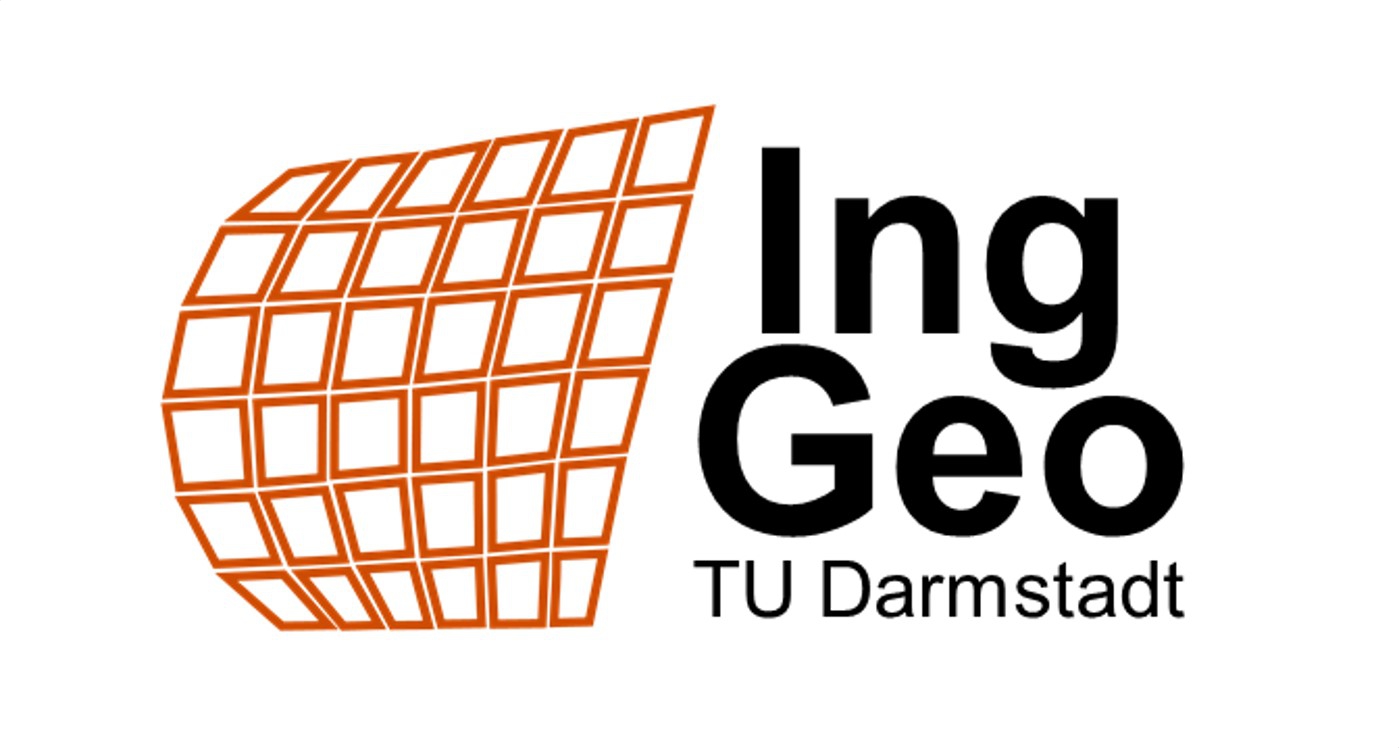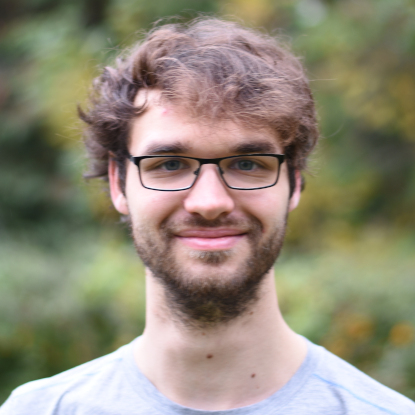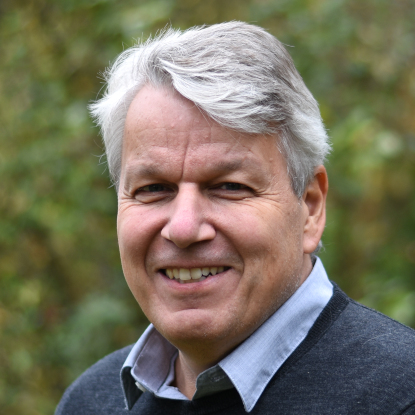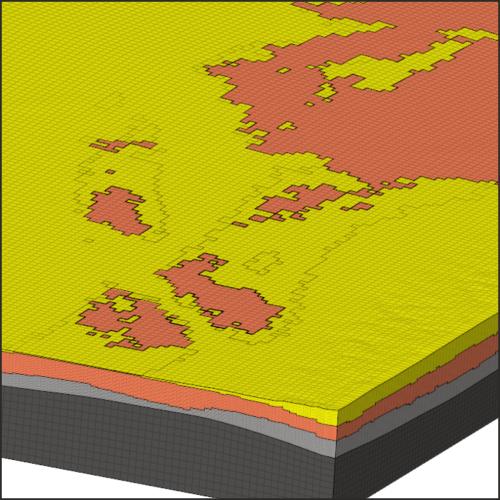
Facts about the project
PhD project: Dr. Steffen Ahlers +++ Duration: 15.05.2018 – 31.12.2021 +++ Project funding: Bundesministerium für Wirtschaft und Energie (BMWi) Projektträger Karlsruhe
The tectonic stress field in the Earth's crust affects a variety of site selection criteria for radioactive waste disposal. However, a reliable prediction in advance of exploration activities is complicated by the fact that the stress field is not uniform in its orientation and magnitude. Rather, depending on the subsurface structure (lithologies, faults), significant local deviations from the regional stress distribution can occur. In order to achieve a process-based understanding of this spatial variability, a numerical-geomechanical 3D model for Germany (dimensions approx. 1250 x 1000 x 100 km³) is created. This model is calibrated using measured stress data and allows predictions for areas without stress data and the derivation of all six components of the stress tensor based on continuum mechanical approaches.
The model generation is done in two steps. First, a geological model is created that represents the subsurface structure in the model area. This geological model is created on the basis of already existing models covering different parts of the working area and seismic sections. In the second step this model is discretized. The current model is based on 5 surfaces: Topography, top of the crystalline basement, top of the lower crust, Moho discontinuity and the model base. This results in 4 model units: sedimentary cover, crystalline basement of the upper crust, lower crust and lithospheric mantle. The model is discretised, parameterised and boundary conditions are defined. The stress field is calculated using an implicit finite element solver. The results are evaluated and the boundary conditions are adjusted until the best fit is achieved. The orientation of the largest horizontal stress and the magnitudes of the largest and least horizontal stress are used as calibration data.
Publications
- Röckel, L., Ahlers, S., Müller, B., Reiter, K., Heidbach, O., Henk, A., Hergert, T., Schilling, F.: The analysis of slip tendency of major tectonic faults in Germany, Solid Earth, 13, 1087-1105, https://doi.org/10.5194/se-13-1087-2022, 2022.
- Ahlers, S., Röckel, L., Hergert, T., Reiter, K., Heidbach, O., Henk, A., Müller, B., Morawietz, S., Scheck-Wenderoth, M., Anikiev, D.: The crustal stress field of Germany: a refined prediction, Geothermal Energy 10, 10, https://doi.org/10.1186/s40517-022-00222-6, 2022.
- Ahlers, Steffen ; Henk, Andreas ; Hergert, Tobias ; Reiter, Karsten ; Müller, Birgit ; Röckel, Luisa ; Heidbach, Oliver ; Morawietz, Sophia ; Scheck-Wenderoth, Magdalena ; Anikiev, Denis (2021), 3D crustal stress state of Germany according to a data-calibrated geomechanical model, Solid Earth, 12 (8), DOI:: 10.5194/se-12-1777-2021.
- Ahlers, S., Henk, A. Hergert, T., Reiter, K., Müller, L., Heidbach, O., Morawietz, S., Scheck-Wenderoth, M., Anikiev, D. (2020), 3D crustal stress state of Western Central Europe according to a data-calibrated geomechanical model — first results, Solid Earth Discussions, EGU, DOI: 10.5194/se-2020-199.
- Ahlers, S., Henk, A. Hergert, T., Reiter, K., Müller, L., Heidbach, O., Morawietz, S., Scheck-Wenderoth, M., Anikiev, D. (2020), 3D crustal stress state of Western Central Europe according to a data-calibrated geomechanical model — first results, Solid Earth Discussions, EGU, DOI: 10.5194/se-2020-199.
- Ahlers, S., Hergert, T., Henk, A., 2019. Numerical Modelling of Salt-Related Stress Decoupling in Sedimentary Basins–Motivated by Observational Data from the North German Basin. Special issue on Stress Quantification in Sedimentary Basins, Geosciences, 9, 19, https://doi.org/10.3390/geosciences9010019.
- Ahlers, S., Hergert, T., Henk, A., 2019. Numerical Modelling of Salt-Related Stress Decoupling in Sedimentary Basins–Motivated by Observational Data from the North German Basin. Special issue on Stress Quantification in Sedimentary Basins, Geosciences, 9, 19, https://doi.org/10.3390/geosciences9010019.
Data Publikcations
- Ahlers, S., Henk, A., Hergert, T., Reiter, K., Müller, B., Röckel, L., Heidbach, O., Morawietz, S., Scheck-Wenderoth, M., and Anikiev, D.: The Crustal stress state of Germany – Results of a 3D geomechnical model v2.0. https://tudatalib.ulb.tu-darmstadt.de/handle/tudatalib/2624.5, 2021.
- Ahlers, S., Henk, A., Hergert, T., Reiter, K., Müller, B., Röckel, L., Heidbach, O., Morawietz, S., Scheck-Wenderoth, M., und Anikiev, D.: The Crustal stress state of Germany – Results of a 3D geomechnical model. https://doi.org/10.48328/tudatalib-437, 2021.
Conference Contributions
- The SpannEnD project – Prediction of the recent crustal stress field of Germany, 2022, Ahlers, S., Morawietz, S., Röckel, L., Henk, A., Reiter, K., Hergert, T., Müller, B., Heidbach, O., TSK 2019 Halle (Saale), 9-11. März 2022, Halle (Saale), Germany Poster.
- An Open-Access Stress Magnitude Database for Germany, 2021, Morawietz, S., Ziegler, M., Reiter, K., and the SpannEnD Project Team, SafeND, 9-12. Dezember 2021, Berlin, Germany Abstract Poster.
- Slip tendency analysis of major faults in Germany, 2021, Röckel, L., Ahlers, S., Morawietz, S., Müller, B., Reiter, K., Heidbach, O., Henk, A., Hergert, T., and Schilling, F., SafeND, 9-12. Dezember 2021, Berlin, Germany Abstract Poster.
- The recent stress state of Germany – results of a geomechanical–numerical 3D model, 2021, Ahlers, S., Henk, A., Hergert, T., Reiter, K., Müller, B., Röckel, L., Heidbach, O., Morawietz, S., Scheck-Wenderoth, M., and Anikiev, D., SafeND, 9-12. Dezember 2021, Berlin, Germany Abstract
- The SpannEnD project: 3-D stress prediction in the upper crust of Germany, 2021, Reiter, K., Ahlers, S., Morawietz, S., Röckel, L., Hergert, T., Henk, A., Müller, B., and Heidbach, O., SafeND, 9-12. Dezember 2021, Berlin, Germany Abstract.
- Slip tendency analysis for 60 3D faults in Germany and adjacent areas, Röckel, L., Ahlers, S., Müller, B., Reiter, K., Heidbach, O., Hergert, T., Henk, A., Schilling, F., GeoKarlsruhe 2021, 19-24. September 2021, Karlsruhe, Germany.
- SpannEnD – The crustal stress state of Germany, 2021, Ahlers, S., Röckel, L., Henk, A., Reiter, K., Hergert, T., Müller, B., Schilling, F., Heidbach, O., Morawietz, S., Scheck-Wenderoth, M., Anikiev, D., GeoKarlsruhe 2021, 19-24. September 2021, Karlsruhe, Germany.
- The SpannEnD project – Towards a robust prediction of the 3D stress state in the upper crust of Germany, Reiter, K., Ahlers, S., Morawietz, S., Röckel, L., Hergert, H., Henk, A., Müller, B., Heidbach, O., GeoKarlsruhe 2021, 19-24. September 2021, Karlsruhe, Germany.
- Datenbank zu Magnituden von Gebirgsspannungen in Deutschland, 2019, Morawietz, S., Heidbach, O., Reiter, K., Ziegler, M., Team SpannEnD, Tage der Standortauswahl – 3. Fachworkshop der Bundesgesellschaft für Endlagerung, 12.-14. Dezember 2019, Braunschweig, Germany Poster.
- Projekt SpannEnD – Spannungsmodell Endlagerung Deutschland, 2019, Reiter, K., Ahlers, S., Heidbach, O., Henk, A., Hergert, T., Morawietz, S., Müller, B., Röckel, L.,Schilling, F., Tage der Standortauswahl – 3. Fachworkshop der Bundesgesellschaft für Endlagerung, 12.-14. Dezember 2019, Braunschweig, Germany.
- SpannEnD – Modelling the 3D stress state of Germany, 2019, Röckel, L., Ahlers, S., Morawietz, S., Müller, B., Schilling, F., Reiter, K., Henk, A., Hergert, T., Heidbach, O., Anikiev, D., Scheck-Wenderoth, M., Student Technical Congress (STC 2019), 14.-15. November 2019 Aachen, Germany Poster.
- SpannEnD – Modelling the 3D stress state of Germany , 2019, Ahlers, S., Röckel, L., Henk, A., Reiter, K., Hergert, T., Müller, B., Schilling, F., Heidbach, O., Morawietz, S., Scheck-Wenderoth, M., Anikiev, D., GeoMünster2019, 22-25. September 2019, Münster, Germany.
Status Quo & Outlook
A first geomechanical-numerical model for Germany calibrated using in situ stress measurements has been created and published. A further publication about the stratigraphic refinement of the sedimentary unit and the increase of the model resolution is.in progress.



